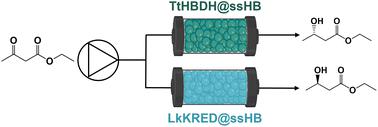当前位置:
X-MOL 学术
›
Green Chem.
›
论文详情
Our official English website, www.x-mol.net, welcomes your feedback! (Note: you will need to create a separate account there.)
Enantiodivergent biosynthesis of β-hydroxy esters by self-sufficient heterogeneous biocatalysts in a continuous flow
Green Chemistry ( IF 9.8 ) Pub Date : 2024-03-12 , DOI: 10.1039/d4gc00369a Daniel Andrés-Sanz 1 , Ainhoa Maiz-Iginitz 1, 2 , Juan M. Bolivar 3 , Alejandro H. Orrego 1 , Haritz Sardon 2 , Fernando López-Gallego 1, 4
Green Chemistry ( IF 9.8 ) Pub Date : 2024-03-12 , DOI: 10.1039/d4gc00369a Daniel Andrés-Sanz 1 , Ainhoa Maiz-Iginitz 1, 2 , Juan M. Bolivar 3 , Alejandro H. Orrego 1 , Haritz Sardon 2 , Fernando López-Gallego 1, 4
Affiliation

|
β-Hydroxy esters are essential building blocks utilised by the pharmaceutical and food industries in the synthesis of functional products. The asymmetric reduction of β-keto esters using cell-free enzymes presents a viable approach to manufacture enantiomerically pure β-hydroxy esters. However, the unbearable economic costs underlying enzymes and cofactors call for innovative approaches to maximise their reusability. Herein, we develop two self-sufficient Heterogeneous Biocatalysts (ssHBs) for the enantiodivergent reduction of β-keto esters to yield enantiomerically pure β-hydroxy esters. A thermophilic (S)-3-hydroxybutyryl-CoA dehydrogenase from Thermus thermophilus HB27 (TtHBDH) and an (R)-specific ketoreductase from Lactobacillus kefir (LkKRED) are selected, kinetically characterised, and immobilised onto macroporous agarose beads. Finally, the immobilised enzymes are coated with cationic polymers to co-immobilise the required redox cofactors. The resulting ssHBs catalyse the asymmetric reduction of β-keto esters without the exogenous supply of NAD(P)H and using 2-propanol as an ancillary electron donor. Then, we construct two enantiodivergent packed bed reactors (PBRs) integrating these two ssHBs and determine their optimal operational parameters through condition screening and kinetic simulations. The ssHBs in continuous flow operation exhibit good operational stability, illustrated by a maximum Space-Time Yield (STY) of 49.5 g L−1 h−1 for the continuous production of enantiopure ethyl 3-(R)-hydroxybutyrate over 21 days. Under these conditions, LkKRED and NADPH achieve total turnover numbers of 9.3 × 105 and 2.7 × 104, respectively. Upon mass metric analysis, we conclude that these ssHBs meet the efficiency and sustainability standards to be implemented in some industrial processes, advancing the concept of self-sufficient biocatalysis for process intensification.
中文翻译:

自给自足的多相生物催化剂连续流对映异构体生物合成β-羟基酯
β-羟基酯是制药和食品工业用于合成功能性产品的重要组成部分。使用无细胞酶对 β-酮酯进行不对称还原提供了一种生产对映体纯 β-羟基酯的可行方法。然而,酶和辅因子难以承受的经济成本需要创新方法来最大限度地提高其可重复使用性。在此,我们开发了两种自给自足的异质生物催化剂(ssHBs),用于对映异构体还原β-酮酯,产生对映体纯的β-羟基酯。选择来自嗜热栖热菌HB27 (TtHBDH)的嗜热 ( S )-3-羟基丁酰-CoA 脱氢酶和来自开菲尔乳杆菌(LkKRED) 的 ( R ) 特异性酮还原酶,进行动力学表征,并将其固定到大孔琼脂糖珠上。最后,固定化酶涂有阳离子聚合物,以共固定所需的氧化还原辅因子。由此产生的 ssHBs 催化 β-酮酯的不对称还原,无需外源供应 NAD(P)H,并使用 2-丙醇作为辅助电子供体。然后,我们构建了两个集成这两个 ssHB 的对映异构填充床反应器 (PBR),并通过条件筛选和动力学模拟确定其最佳操作参数。连续流动操作中的ssHBs表现出良好的操作稳定性,在21天内连续生产对映体纯3-( R )-羟基丁酸乙酯的最大时空产率(STY)为49.5 g L -1 h -1 。在这些条件下,LkKRED和NADPH的总转换数分别为9.3×10 5和2.7×10 4。经过质量分析,我们得出结论,这些 ssHB 满足在某些工业过程中实施的效率和可持续性标准,推进了用于过程强化的自给自足生物催化的概念。
更新日期:2024-03-12
中文翻译:

自给自足的多相生物催化剂连续流对映异构体生物合成β-羟基酯
β-羟基酯是制药和食品工业用于合成功能性产品的重要组成部分。使用无细胞酶对 β-酮酯进行不对称还原提供了一种生产对映体纯 β-羟基酯的可行方法。然而,酶和辅因子难以承受的经济成本需要创新方法来最大限度地提高其可重复使用性。在此,我们开发了两种自给自足的异质生物催化剂(ssHBs),用于对映异构体还原β-酮酯,产生对映体纯的β-羟基酯。选择来自嗜热栖热菌HB27 (TtHBDH)的嗜热 ( S )-3-羟基丁酰-CoA 脱氢酶和来自开菲尔乳杆菌(LkKRED) 的 ( R ) 特异性酮还原酶,进行动力学表征,并将其固定到大孔琼脂糖珠上。最后,固定化酶涂有阳离子聚合物,以共固定所需的氧化还原辅因子。由此产生的 ssHBs 催化 β-酮酯的不对称还原,无需外源供应 NAD(P)H,并使用 2-丙醇作为辅助电子供体。然后,我们构建了两个集成这两个 ssHB 的对映异构填充床反应器 (PBR),并通过条件筛选和动力学模拟确定其最佳操作参数。连续流动操作中的ssHBs表现出良好的操作稳定性,在21天内连续生产对映体纯3-( R )-羟基丁酸乙酯的最大时空产率(STY)为49.5 g L -1 h -1 。在这些条件下,LkKRED和NADPH的总转换数分别为9.3×10 5和2.7×10 4。经过质量分析,我们得出结论,这些 ssHB 满足在某些工业过程中实施的效率和可持续性标准,推进了用于过程强化的自给自足生物催化的概念。



























 京公网安备 11010802027423号
京公网安备 11010802027423号